Introduction
In today’s digital era, businesses and developers seek robust, scalable, and high-performing web applications. Full stack development with React.js and Node.js has become a popular choice due to its efficiency, flexibility, and seamless integration between front-end and back-end technologies.
Whether you are a business looking to hire React.js developers or a developer exploring React.js web development, understanding how React and Node.js work together is crucial. This guide will cover the benefits of using React.js and Node.js for full-stack development and how they compare to other technologies like React Native and Node.js vs React.js.
Why Choose React.js and Node.js for Full-Stack Development?
React.js and Node.js complement each other perfectly in a full-stack environment. Here’s why they are a great choice:
1. JavaScript for Both Front-End and Back-End
-
Using JavaScript on both the client and server simplifies development.
-
Developers can switch between front-end and back-end easily.
2. High Performance and Scalability
-
React.js offers a virtual DOM that enhances UI performance.
-
Node.js is non-blocking and event-driven, making it ideal for handling multiple requests efficiently.
3. Rapid Development with Reusable Components
-
React’s component-based architecture speeds up development.
-
Node.js has a vast ecosystem of packages through npm.
4. Seamless API Integration
-
React.js works well with RESTful APIs and GraphQL, which Node.js can easily provide.
5. Large Community Support
-
Both React.js and Node.js have strong communities, extensive documentation, and regular updates.
Setting Up a Full-Stack React and Node.js Application
1. Initialize the Back-End with Node.js and Express.js
Create a new Node.js project:
mkdir fullstack-app && cd fullstack-app
npm init -yInstall Express:
npm install express cors mongoose dotenvCreate a basic Express server (server.js):
const express = require("express");
const cors = require("cors");
const app = express();
app.use(cors());
app.use(express.json());
app.get("/api", (req, res) => {
res.json({ message: "Welcome to the React and Node.js full-stack app!" });
});
app.listen(5000, () => console.log("Server running on port 5000"));2. Build the Front-End with React.js
Set up a new React app:
npx create-react-app client
cd client
npm startModify App.js to fetch data from the Node.js server:
import React, { useEffect, useState } from "react";
function App() {
const [message, setMessage] = useState("");
useEffect(() => {
fetch("http://localhost:5000/api")
.then((response) => response.json())
.then((data) => setMessage(data.message));
}, []);
return <h1>{message}</h1>;
}
export default App;3. Connect to a Database (MongoDB)
Install Mongoose:
npm install mongooseSet up MongoDB connection in server.js:
const mongoose = require("mongoose");
mongoose.connect("your_mongo_connection_url", {
useNewUrlParser: true,
useUnifiedTopology: true,
});
const db = mongoose.connection;
db.once("open", () => console.log("Connected to MongoDB"));4. Deploy the Full-Stack Application
-
Use Vercel or Netlify for React deployment.
-
Use Heroku or DigitalOcean for Node.js deployment.
-
Set up environment variables for database credentials and API keys.
React.js vs Node.js: Understanding the Difference
While React.js and Node.js are often used together, they serve different purposes:
| Feature | React.js | Node.js |
|---|---|---|
| Type | Front-end Library | Back-end Runtime |
| Purpose | UI Development | Server-side Logic |
| Performance | Virtual DOM for fast rendering | Asynchronous, event-driven architecture |
| Use Cases | SPAs, interactive UIs | REST APIs, real-time applications |
Why Hire a Full-Stack Developer for React and Node.js?
If you are looking to build a scalable full-stack application, you should consider hiring a full-stack developer with expertise in React.js and Node.js. Here’s why:
-
Expertise in Both Front-End and Back-End: A full-stack developer can manage the entire development cycle.
-
Faster Development: Having a single developer for both front-end and back-end reduces coordination time.
-
Cost Efficiency: Instead of hiring separate front-end and back-end teams, a full-stack developer can handle both.
-
Seamless Integration: A developer with knowledge of React.js and Node.js can ensure smooth communication between the UI and server.
Conclusion
Full-stack development with React.js and Node.js is an excellent choice for building scalable, high-performance web applications. The combination of React.js web development for the front-end and Node.js for the back-end creates a seamless development experience.
Understanding React js vs Node js and how they compare to React.js vs React Native helps in making informed technology decisions. If you are planning to develop a full-stack app, it’s highly recommended to hire React.js developers or full-stack experts to ensure a smooth and efficient development process.
